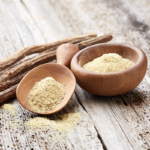
While myths and misconceptions exist about natural ingredients for skincare routines, many natural ingredients are beneficial for the skin. Licorice root was once used to treat conditions such as lung, liver, circulatory, and kidney diseases but has also proven to improve skin conditions, especially those involving redness and irritation. Let’s dig deeper into licorice root benefits for the skin.
What is Licorice Root Extract?
When you hear licorice, you might picture candy twists that sometimes accompany popcorn buckets at the movie theater. Glycyrrhiza glabra (aka licorice root) is the aromatic sweet root that gives the snack a balanced bitter-sweet flavor. But this plant—cultivated in Europe, the Middle East, and Asia— also works wonders for your skin, most notably as a brightening agent.
Licorice Root Extract for Skin Benefits
Here are five common ways licorice root is used in skincare:
- Slowing aging of the skin. Licorice root neutralizes free radicals from the environment and contains flavonoids, plant-derived chemicals that protect against environmental stressors and UV radiation, thereby preventing signs of aging.
- Preventing and treating acne. Oil can clog pores and result in acne. Licorice root produces licochalcone, which helps regulate oil production. And it is an anti-inflammatory that can soothe inflammatory skin processes such as acne, rosacea, eczema, and psoriasis.
- Treating dark spots. When produced in excess, melanin causes hyperpigmentation, otherwise known as dark spots. Licorice root has been found effective for reducing skin pigmentation as it inhibits tyrosinase which in turn stops melanin production.
- Treating under-eye circles. One reason you find licorice root in eye creams is that it can reduce the appearance of under-eye circles through the production of liquiritin, which contributes to its lightening qualities.
- Lightening scars. The ingredient mentioned above, glabridin, is a natural, UV-fighting chemical. It repairs reddened, heat-damaged, sensitive skin and lightens any dark pigments from sun exposure. Glabriden also inhibits an enzyme called tyrosinase, which stops melanin production and lightens scarred skin.
What Makes Licorice Root so Effective?
There are two critical ingredients to licorice root: glycyrrhizin and glabridin. Glycyrrhizin (a constituent) and glabridin (a natural compound) work as an anti-inflammatory serum combatting redness, inflammation, and skin irritation. They’re usable on most skin types and combine well with any secondary ingredient (like antioxidants and skin brightening agents).
How to Use Licorice on Face
You can find licorice root in serums and other skincare products offering a smoother, brighter skin appearance. It is very well tolerated and doesn’t generally cause irritation as it is used to reduce inflammation and itchiness.
Combined with vitamin C and niacinamide, licorice root can protect the skin from sun damage and reduce dark spots more quickly. You’ll achieve the best results when used once or twice per day regularly, and you should apply it before sunscreen.
SkinTherapyMD’s exfoliating pads and serums contain licorice root and other natural ingredients. Our recommended skincare routine is as follows:
- Gently cleanse your face. (Thoroughly remove makeup before washing using a makeup remover if needed).
- Apply CAMU Anti-aging Resurfacing pad or CAMU ClearSkin Resurfacing pad (for acne-prone skin) over the entire face with gentle pressure. You can extend it onto your neck, chest, arms, hands, and any areas of interest until the pad is dry and CAMU Anti-aging (or ClearSkin) exfoliating pad has lost its natural brown color from the ingredients.
- Follow with the CAMU Anti-aging Moisturizing Serum or CAMU ClearSkin Moisturizing Serum (for acne-prone skin).
- Apply sun protection following the morning serum. You can also apply your favorite moisturizer following the serum if more hydration is desired.
About the Author
Melanie Kingsley, MD, is a fellowship-trained, board-certified dermatologist. She helped found SkinTherapyMD to develop safe and effective skincare products. Our mission is to help customers achieve healthy skin with proven results in fewer steps so that they can feel their best with our medically-based, scientific skincare products.